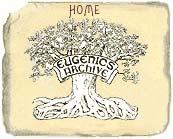
Scientific Origins of Eugenics
Elof Carlson, State University of New York at Stony Brook
The eugenics movement arose in the 20th century as two wings of a common philosophy of human worth. Francis Galton, who coined the term eugenics in 1883, perceived it as a moral philosophy to improve humanity by encouraging the ablest and healthiest people to have more children. The Galtonian ideal of eugenics is usually termed positive eugenics. Negative eugenics, on the other hand, advocated culling the least able from the breeding population to preserve humanity's fitness. The eugenics movements in the United States, Germany, and Scandinavia favored the negative approach.
The notion of segregating people considered unfit to reproduce dates back to antiquity. For example, the Old Testament describes the Amalekites – a supposedly depraved group that God condemned to death. Concerns about environmental influences that might damage heredity – leading to ill health, early death, insanity, and defective offspring – were formalized in the early 1700s as degeneracy theory. Degeneracy theory maintained a strong scientific following until late in the 19th century. Masturbation, then called onanism, was presented in medical schools as the first biological theory of the cause of degeneracy. Fear of degeneracy through masturbation led Harry Clay Sharp, a prison physician in Jeffersonville, Indiana, to carry out vasectomies on prisoners beginning in 1899. The advocacy of Sharp and his medical colleagues, culminated in an Indiana law mandating compulsory sterilization of "degenerates." Enacted in 1907, this was the first eugenic sterilization law in the United States.
By the mid-19th century most scientists believed bad environments caused degenerate heredity. Benedict Morel's work extended the causes of degeneracy to some legitimate agents – including poisoning by mercury, ergot, and other toxic substances in the environment. The sociologist Richard Dugdale believed that good environments could transform degenerates into worthy citizens within three generations. This position was a backdrop to his very influential study on The Jukes (1877), a degenerate family of paupers and petty criminals in Ulster County, New York. The inheritance of acquired (environmental) characters was challenged in the 1880s by August Weismann, whose theory of the germ plasm convinced most scientists that changes in body tissue (the soma) had little or no effect on reproductive tissue (the germ plasm). At the beginning of the 20th century, Weismann's views were absorbed by degeneracy theorists who embraced negative eugenics as their favored model.
Adherents of the new field of genetics were ambivalent about eugenics. Most basic scientists – including William Bateson in Great Britain, and Thomas Hunt Morgan in the United States – shunned eugenics as vulgar and an unproductive field for research. However, Bateson's and Morgan's contributions to basic genetics were quickly absorbed by eugenicists, who took interest in Mendelian analysis of pedigrees of humans, plants, and animals. Many eugenicists had some type of agricultural background. Charles Davenport and Harry Laughlin, who together ran the Eugenics Record Office, were introduced through their shared interest in chicken breeding. Both also were active in Eugenics Section of the American Breeder's Association (ABA). Davenport's book, Eugenics: The Science of Human Improvement through Better Breeding, had a distinct agricultural flavor, and his affiliation with the ABA was included under his name on the title page. Agricultural genetics also provided the favored model for negative eugenics: human populations, like agricultural breeds and varieties, had to be culled of their least productive members, with only the healthiest specimens used for breeding.
Evolutionary models of natural selection and dysgenic (bad) hereditary practices in society also contributed to eugenic theory. For example, there was fear that highly intelligent people would have smaller families (about 2 children), while the allegedly degenerate elements of society were having larger families of four to eight children. Public welfare might also play a role in allowing less fit people to survive and reproduce, further upsetting the natural selection of fitter people.
Medicine also put its stamp on eugenics. Physicians like Anton Ochsner and Harry Sharp were convinced that social failure was a medical problem. Italian criminologist and physician Cesare Lombroso popularized the image of an innate criminal type that was thought to be a reversion or atavism of a bestial ancestor of humanity. When medical means failed to help the psychotic, the retarded, the pauper, and the vagrant, eugenicists shifted to preventive medicine. The German physician-legislator Rudolph Virchow, advocated programs to deal with disease prevention on a large scale. Virchow's public health movement was fused with eugenics to form the racial hygiene movement in Germany – and came to America through physicians he trained.
Eugenicists argued that "defectives" should be prevented from breeding, through custody in asylums or compulsory sterilization. Most doctors probably felt that sterilization was a more humane way of dealing with people who could not help themselves. Vasectomy and tubal ligation were favored methods, because they did not alter the physiological and psychological contribution of the reproductive organs. Sterilization allowed the convicted criminal or mental patient to participate in society, rather than being institutionalized at public expense. Sterilization was not viewed as a punishment because these doctors believed (erroneously) that the social failure of "unfit" people was due to an irreversibly degenerate germ plasm.
